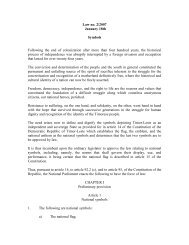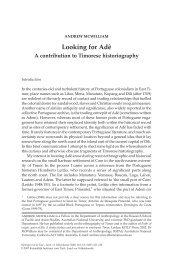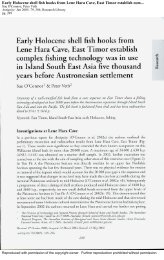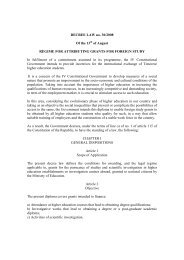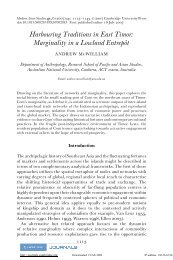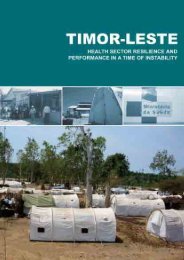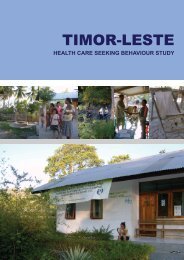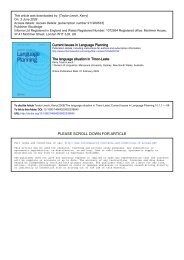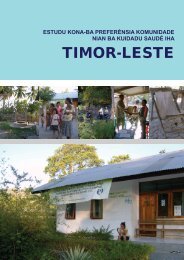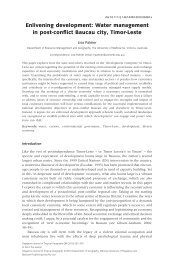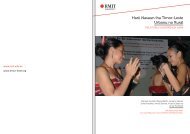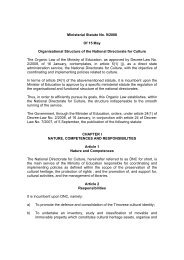Local Governance in Timor-Leste - Secretaria de Estado da Arte e ...
Local Governance in Timor-Leste - Secretaria de Estado da Arte e ...
Local Governance in Timor-Leste - Secretaria de Estado da Arte e ...
- No tags were found...
You also want an ePaper? Increase the reach of your titles
YUMPU automatically turns print PDFs into web optimized ePapers that Google loves.
played out s<strong>in</strong>ce <strong>de</strong>colonisation. This policy cycle plays out <strong>in</strong> different formsbetween two oppos<strong>in</strong>g ontological positions, where some (Kaufmann et. al. 2008;Scott and Wil<strong>de</strong> 2006) argue that the <strong>de</strong>velopment agen<strong>da</strong> can be pursued to shapesocietal outcomes through <strong>in</strong>stitutional <strong>in</strong>terventions, whereas others (Jenk<strong>in</strong>s andPlow<strong>de</strong>n 2006; Ran<strong>de</strong>l et al 2004) dismiss this approach as <strong>in</strong>effective andi<strong>de</strong>ologically flawed. I argue that this policy cycle can be traced back to theun<strong>de</strong>rly<strong>in</strong>g b<strong>in</strong>ary of tradition and mo<strong>de</strong>rnity that fails to recognise and engage withthe every<strong>da</strong>y politics of mutual recognition.I trace this policy cycle to the ontological divi<strong>de</strong> between structure and agency with<strong>in</strong>functional approaches to <strong>in</strong>stitutionalism. I argue that if we take a critical approach to<strong>in</strong>stitutionalism that recognises the importance of local politics and <strong>in</strong>corporates thepolitics of mutual recognition we can account for coexist<strong>in</strong>g mo<strong>de</strong>rn and traditional<strong>in</strong>stitutional structures, while simultaneously <strong>in</strong>corporat<strong>in</strong>g these <strong>in</strong> the realities oflocal politics. This gives us a conceptual framework through which we can recognisethe various forms of political hybridity that result from coexist<strong>in</strong>g <strong>in</strong>stitutionalstructures, and also serves to explicate the 'shadow si<strong>de</strong>' of these politics, whereexist<strong>in</strong>g power <strong>in</strong>equalities are reproduced through different <strong>in</strong>stitutional forms.In chapter four, I provi<strong>de</strong> an overview of the governance history of <strong>Timor</strong>-<strong>Leste</strong>,trac<strong>in</strong>g the <strong>de</strong>velopment of coexist<strong>in</strong>g traditional and overarch<strong>in</strong>g <strong>in</strong>stitutionalstructures through pre-colonial, Portuguese, Indonesian, UNTAET and present <strong>da</strong>ygovernance. Throughout these various stages of history, traditional <strong>in</strong>stitutionalstructures have gui<strong>de</strong>d the lives of those with<strong>in</strong> the suku. While the rule of the liurai 9is now over, the liurai house is still important <strong>in</strong> many communities and primaryloyalty cont<strong>in</strong>ues to be owed to the small k<strong>in</strong>-based groups bound together throughuma lulik 10 . Over the centuries a close symbiosis between traditional <strong>in</strong>stitutionalstructures and these small k<strong>in</strong>-based groups has <strong>de</strong>veloped and become entrenched,which has endowed traditional <strong>in</strong>stitutions with political and economic significance.With<strong>in</strong> this context, local un<strong>de</strong>rstand<strong>in</strong>gs of community that are shaped throughtraditional <strong>in</strong>stitutions have provi<strong>de</strong>d the basic political environment <strong>in</strong>to which9 Liurai: k<strong>in</strong>g.10 Uma Lulik: sacred house.22



